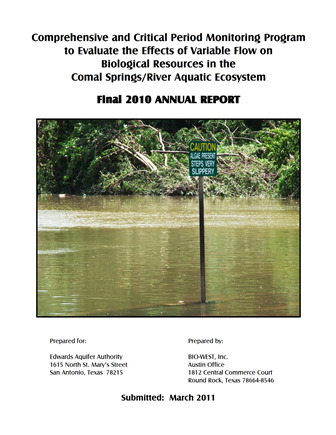Comprehensive and Critical Period Monitoring Program to Evaluate the Effects of Variable Flow on Biological Resources in the Comal Springs/River Aquatic Ecosystem Final 2010 Annual Report

| Summary |
|
The purpose of this report is to document the results of all aquatic ecosystem monitoring conducted in 2010 at Comal Springs located in New Braunfels, Texas. The monitoring and report preparation was performed by BIO-WEST, Inc. Pflugerville, Texas. [Excerpted from the Executive Summary] Aquatic vegetation at the four study reaches were affected by increased spring flows and the flood event in 2010. The flooding in June changed the Upper Spring Run Reach the most because a lot of the flow came down Blieder’s Creek, hich enters the Comal River just upstream of this reach. Over 80% of the aquatic vegetation in this reach was removed by the high-flow event, and only strongly-rooted Sagittaria remained. By fall, Hygrophila and bryophytes had regained a toe-hold in the reach, but vegetation remained scarce…. Other native vegetation (Ludwigia, Sagittaria, Cabomba) were reduced after the flood, but by fall they had reestablished in most areas where they were previously found…. Unfortunately, flooding in June decimated much of the bryophytes and filamentous algae which are most vulnerable to scouring in high flows. This resulted in the lowest normalized population estimate of fountain darters since the inception of the study. Impacts were most notable at the Old Channel and Upper Spring Run sites because much of the vegetation was removed in these reaches (filamentous algae and bryophytes were absent from both sites in June). Fountain darter populations began to recover by fall, and if previous high-flow events are any indication, they should continue to increase as aquatic vegetation grows back…. Gill parasites in the Comal River were monitored throughout 2010. A specific study at three sites was conducted to compare overall gill parasite concentrations from 2010 to those observed during 2006. A significant decline in cercarial densities was observed from 2006 to 2010…. Comal Springs salamander (Eurycea sp.) populations decreased at all sites following the June flood except at the Spring Island East Outfall. Sampling of invertebrate populations is confined to areas near spring upwellings because these animals often are not observed until they are released or come out of the springs. As a result, these populations seemed less affected by the flooding than other aquatic organisms studied in the Comal River. Unfortunately, the flooding did affect the Comal Springs riffle beetle (Heterelmis comalensis) sampling effort because many of the lures (cotton rags) used to catch these invertebrates were washed away or buried by shifting substrates. In 2010, a new locality for the Comal Springs riffle beetle and Peck’s Cave amphipod (Stygobromus pecki) was chosen just downstream of the confluence of Spring Runs 1 and 2. As in previous years, populations were patchily distributed and abundance varied considerably in 2010. The flood in June resulted in a myriad of effects on the biota in the system. Data from the past 10 years indicate that the Comal River/Springs ecosystem contains a highly resilient ecological community that is able to withstand these types of events. However, anthropogenic and natural stressors will likely continue to exacerbate the magnitude and frequency of high and low-flow events into the future. Therefore, continued monitoring and applied research will be vital to provide guidance on management strategies necessary for preserving this unique ecosystem. |
Search for Documents
Advance Search
Explore EAA's Scientific Reports
- All Reports
- History
- Groundwater Recharge, Recharge Zone
- Groundwater Movement
- Geomorphology and Caves
- Weather Modification
- Geology
- Water Use and Conservation
- Geochemistry
- Water Resources Planning and Management
- Floods and Drought
- Water Quality
- Climatology
- Surface Water / Groundwater Relationship
- Biology
- Springs, Groundwater Discharge
- Archaeology
- RZ Protection
- Aquifer Levels
- Remote Sensing
- Precipitation
- Overview Studies
- Modeling
- Hydrology and Hydrogeology
